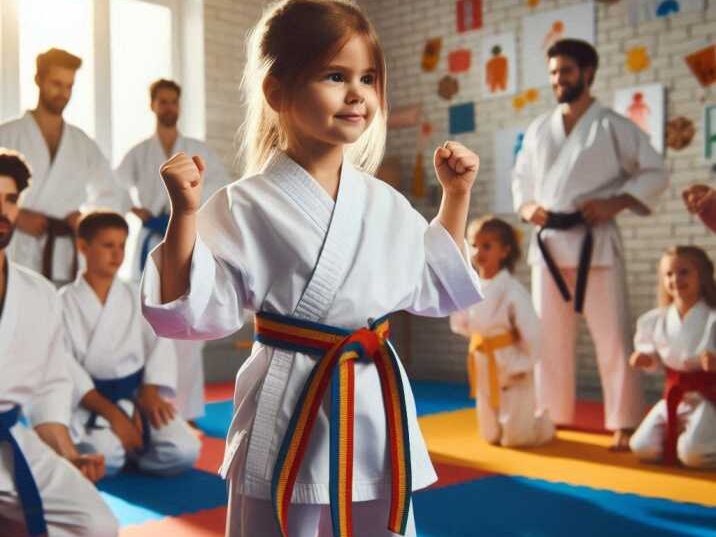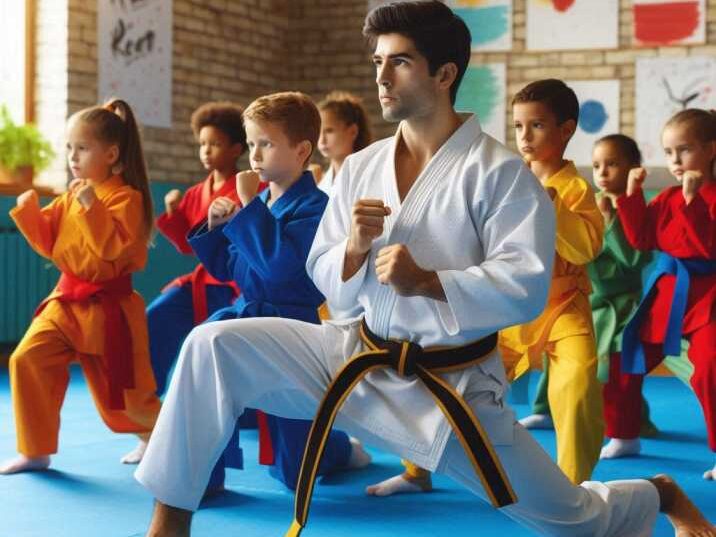1. Introduction
Table of Contents
Every parent wants their child to succeed in school. Good grades and strong focus often go hand in hand. But in today’s world, distractions are everywhere, from video games to social media.
Many parents search for activities that improve both physical and mental skills. One option that continues to grow in popularity is martial arts for kids. Far more than just kicks and punches, martial arts teaches children how to pay attention, control their impulses, and stay motivated.
This article explains how martial arts helps children focus better in school. You’ll see the science, the benefits, the safety tips, and how parents can support their child’s journey.

What Martial Arts and Focus Mean
Martial arts are structured physical practices like karate, taekwondo, judo, or Brazilian jiu-jitsu. They combine movement, discipline, and respect.
Focus means the ability to pay attention to one task without being distracted. For school-age children, focus is critical for reading, writing, listening to teachers, and completing homework.
Martial arts strengthen this skill because students must follow instructions, stay disciplined, and repeat techniques with patience.
Benefits of Martial Arts for Kids’ Focus
1. Improves Attention Span
Children in martial arts are trained to follow instructions step by step. Even small mistakes mean repeating the move, which teaches patience and concentration. Over time, they develop the habit of blocking out distractions to complete the task correctly. This skill directly transfers to school, where kids must focus on reading, writing, and listening to teachers. The practice of paying attention in class becomes easier because they have already built strong focus in the dojo.
2. Builds Self-Discipline
Martial arts emphasize effort, respect, and responsibility. Kids quickly learn that shortcuts don’t work; progress comes only through consistent practice. Unlike team sports where someone else might cover for mistakes, martial arts require each student to stay accountable. This builds a sense of personal discipline that supports schoolwork, such as completing homework on time or studying for tests. When children understand that steady effort brings results, they approach academics with the same dedication.
3. Reduces Stress and Anxiety
School often creates pressure through tests, grades, and social challenges. Martial arts provide a safe outlet for releasing stress through movement and controlled breathing. Physical exercise releases endorphins, which naturally improve mood and reduce anxiety. The focus on calm breathing and mindfulness helps children relax their minds and control emotions. A child who feels less stressed can concentrate better on lessons and manage challenges in school more effectively. Martial arts give them tools to stay balanced inside and outside the classroom.
4. Enhances Memory and Learning Skills
Martial arts forms, also called katas or patterns, involve learning precise sequences of movements. Kids must remember these steps in order and perform them accurately. This practice strengthens working memory, the same skill used for spelling words, solving math problems, and recalling facts. Repeatedly practicing sequences also trains the brain to organize and retain information. As children sharpen their memory in martial arts, they find it easier to learn and recall lessons in school.
5. Builds Confidence
Confidence is a key factor in how well kids perform academically. Martial arts help children set goals, such as earning belts, and celebrate their progress along the way. Achievements in training show them that hard work pays off, which boosts self-belief. Confident children are more willing to participate in class, answer questions, and take on challenges. They also handle mistakes better, viewing them as chances to learn rather than failures. This positive attitude helps them stay focused and motivated in school.
Possible Risks or Concerns
Parents may worry about martial arts being too aggressive or unsafe. Here are common concerns:
1. Risk of Injury
Parents often worry that martial arts may cause injuries like sprains or bruises. While no physical activity is completely risk-free, martial arts schools place strong emphasis on safety. Instructors teach children how to fall correctly, use protective gear, and practice controlled movements. Most injuries that occur are minor and less frequent than in contact sports like football. When parents choose a reputable school, the risk of serious injury becomes very low.
2. Encouraging Violence
Another concern is that martial arts training might make children aggressive or more likely to fight. In reality, well-structured programs focus heavily on discipline, respect, and self-control. Children are taught that martial arts are for defense only, not for hurting others. Instructors often remind students to use their skills responsibly, both inside and outside class. Many parents notice their children becoming calmer and more respectful, not violent, after joining martial arts.
3. Time Commitment
Martial arts training require consistent attendance, which can feel demanding for families with busy schedules. Children often train two or three times per week, which may seem like a lot at first. However, this routine teaches kids responsibility and time management. Many parents find that the benefits, such as improved focus and confidence, outweigh the scheduling effort. With careful planning, martial arts can fit into a child’s school and activity schedule without becoming overwhelming.
Safety Tips and Best Practices for Parents
To ensure a positive experience:
1. Choose a Certified Martial Arts School with Experienced Instructors
Not all schools follow the same standards, so it’s important to research before enrolling your child. Look for schools with certified instructors who have both teaching and martial arts experience. Experienced teachers know how to guide kids safely and adjust techniques for different ages. A qualified school also places strong emphasis on discipline, respect, and safety.
2. Ask About the Safety Rules and First Aid Policies
Every good martial arts program should have clear safety guidelines. Parents should ask how the school handles accidents and whether instructors are trained in first aid. This shows the school takes student safety seriously and is prepared for emergencies. Having clear rules also helps children understand boundaries and practice responsibly.
3. Make Sure Your Child Wears Proper Gear Like Pads or Mouthguards
Protective gear is essential in martial arts training. Items like mouthguards, shin guards, and padded gloves reduce the chance of injury during practice or sparring. Parents should ensure their child wears the right equipment every session, even for lighter drills. Consistent use of gear builds safe habits that protect kids in the long run.
4. Encourage Regular Practice but Avoid Overtraining
Consistency is important for progress, but too much training can lead to exhaustion or injury. Two to three classes a week are usually enough for school-age children. Parents should balance martial arts training with schoolwork, rest, and other activities. A healthy routine keeps kids motivated and prevents burnout.
5. Support Your Child Without Adding Pressure
Martial arts for kids should be a positive experience, not a source of stress. Parents can show support by attending classes, celebrating small improvements, and encouraging effort. Avoid pushing for perfection or comparing your child to others. When kids feel supported rather than pressured, they enjoy learning and stay committed longer.
How Martial Arts Training Compare to Other Activities for Focus
Soccer
Soccer improves teamwork and physical fitness, but children often rely on the whole team to stay engaged. Focus may shift depending on the position they play. Martial arts training, however, demand individual attention and responsibility at every moment. Each child must stay alert, making it better for building focus.
Dance
Dance helps with memory and rhythm, but routines often focus more on performance than discipline. Martial arts, in contrast, mix memory with structure, respect, and self-control. Children must remember techniques while also following strict rules, which makes focus training more consistent.
Music
Learning music sharpens memory and creativity, but practice usually happens alone. Martial arts combine group instruction with individual responsibility, creating a balance of social learning and personal discipline. The physical activity also releases energy, helping kids calm their minds before focusing on academics.
Why Martial Arts Stand Out
What makes martial arts unique is the mix of physical training, mental discipline, and character-building. Unlike other activities, martial arts constantly reinforce respect, patience, and structured routines. These values help children not only in class but also in daily school life where focus is critical.

Table: Benefits vs. Concerns of Martial Arts for Kids
| Benefits | Concerns | How to Manage |
|---|---|---|
| Better focus and attention | Risk of injury | Use protective gear, choose safe school |
| Self-discipline | Fear of aggression | Ensure program emphasizes respect |
| Reduced stress | Time commitment | Balance school and classes |
| Confidence | Parental worry | Stay involved and communicate with instructors |
| Memory skills | Cost of classes | Look for community centers with affordable programs |
Conclusion
Martial arts training give children more than physical strength. They provide mental tools that improve attention, memory, discipline, and confidence. These skills directly help kids perform better in school.
If you’re looking for a way to help your child focus, consider enrolling them in a martial arts program. Choose a safe, supportive school, stay involved as a parent, and encourage consistent practice.
With time, you’ll likely see your child becoming calmer, more disciplined, and more focused both in the dojo and the classroom.
FAQs
Q1: At what age can my child start martial arts?
Most schools accept children as young as 4 or 5 years old. Programs are adjusted to match attention span and physical ability.
Q2: How many times a week should my child practice?
Two to three classes per week is ideal. It allows progress without overwhelming school responsibilities.
Q3: Can martial arts help children with ADHD?
Yes. The structured environment, clear rules, and physical activity help kids with ADHD build focus and self-control.
Q4: Will martial arts make my child aggressive?
No. Good programs emphasize respect, self-control, and peaceful conflict resolution.
Q5: How soon will I see improvement in school focus?
Most parents notice positive changes within a few months of consistent practice. Results vary by child and school program.


